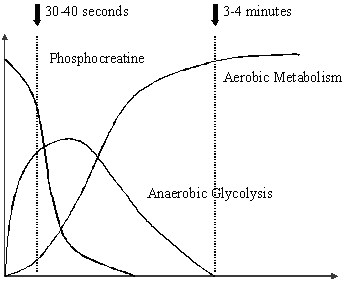|
Measurement Protocol Frank Plasschaert The validity and clinical application of energy expenditure measurements is dependent on its repeatability. So far there is no standard protocol readily available. However, several factors need to be considered: 1. steady state - duration for the walk: Under normal physiologic conditions, prior to the attainment of steady state, energy sources are both aerobic and anaerobic. Aerobic steady state is considered to be present when “…the oxygen uptake corresponds to the demands of the tissues…”. On average one can consider the first three minutes of walking as the time needed to obtain steady state. A walk between 8 to 10 minutes is considered needed to obtain a representative energy cost measurement. Only under these conditions there is a linear relationship between HR and oxygen uptake.
One should however realise that steady state although desirable, is not always attainable. It is important to appreciate that there are two spectral extremes of energy cost at preferred walking speed. There are those that require minimal energy to walk and thus are likely to achieve steady state, conversely there are those that display extreme energy costs of walking and there for ‘max out’ long before attaining steady state. 2. walking speed: It was shown by Inman that preferred walking speed consistently provides the subject’s lowest PCI in both normal and impaired subjects. Walking slower or faster requires greater energy per unit distance and therefore causes an increase in PCI. It may be argued that in children with disabilities walking at their self selected speed with the usual aids (eg crutches) and orthoses offers the best reproduction of their functional level of locomotion in the community. Maximal aerobic power is seldom a limiting factor in a disabled child’s ability to perform daily living tasks as this population is limited by factors such as muscle strength more than their oxygen transport system (Bar-Or 1996). For example, the correlation between VO2max and walking performance measures has been found to be low along adolescents with severe spastic cerebral palsy and poliomyelitis. Thus, energy expenditure measurements at submaximal comfortable walking speeds are more relevant to patients with neuromuscular conditions (Bar-Or 1996). 3. design of the walkway: Since the attainment of steady state is time dependent, it is more appropriate to consider the walkway design in terms of duration walked, rather than distance walked. In most clinical settings the protocol has to be forced to fit the available space. Looped walkways allow uninterrupted walks. Rectangular walkways can influence the pattern of gait and the walking speed at the corners. This effect may be reduced by using an oval track, but with this design patients may exhibit a left or right bias. The figure of eight design is compact and provides a balance for any left/right bias. 4. treadmill or free walking: The use of a treadmill or a bicycle with an imposed speed may adversely affect the gait pattern of a patient with cerebral palsy, and the measured expenditure therefore no longer reflects his true efficiency for locomotion. Furthermore, even when a period of accustomisation is used, treadmills can still yield unrealistic walking speeds. This was noted by Bailey and Radcliffe, who, from one able bodied adult recorded a treadmill walking speed of 28.3 m/minute, which is more than 50% slower than the normal adult. Additionally, for those with low endurance, the accustomisation period may expend significant proportions of their energy reserves. 5. time of day: 6. food intake: One should be ware of the effect of food intake on energy expenditure measurements. It is however clinically unpractical to starve children for 10 to 12 hours prior to their gait assessment. References 1. Inman V.: Conservation of energy in ambulation. Bull Prosthet Res 1968; 10:9-26 Bailey MJ, Ratcliffe CM. Reliability of physiological cost index measurements in walking normal subjects using steady-state, non-steady state and post-exercise heart rate recording. Physiotherapy 1995; 81 (10): 618-623 |

